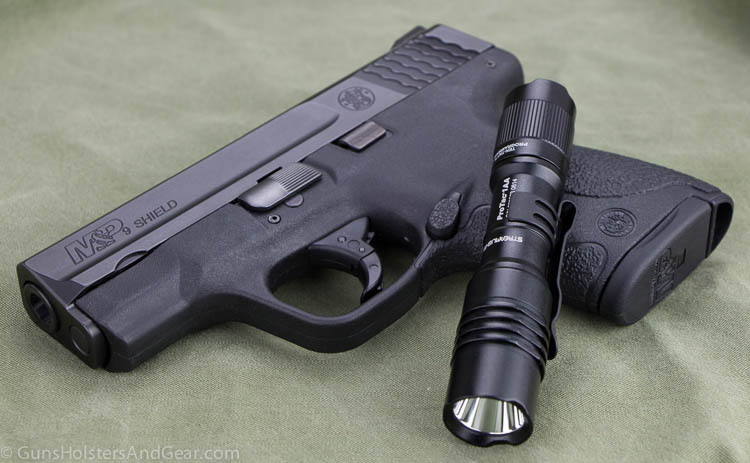Small, lightweight and reliable – what else would one want from a ‘carry everywhere’ flashlight? That’s just what you get from Streamlight in the ProTac 1AA.
In this review, I take a look at one of the smaller lights in the Streamlight catalog. Does it have a role in your self-defense needs? How does it compare to some of the other flashlights I have reviewed?
Ed. Note: This review is on the original ProTac 1AA flashlight. Since that time, Streamlight upgraded the light to the ProTac 1L-1AA. The new 1L-1AA is a dual fuel unit that can also run on a CR123A and throw a lot more light. Specs are below and more information can be found through our affiliate link here.
Let’s start at the beginning…
General Information
Size is probably the most obvious thing that sets this light apart from many of the tactical handheld lights I’ve reviewed on GunsHolstersAndGear.com. The ProTac 1AA is just a hair over 4″ and weighs a mere 2.3 ounces with a single AA battery.
Streamlight uses a LED in the ProTac 1AA to produce a bright white light. I detail the measured output levels in the Output Over Time section below.
A rubber-covered switch is located in the tail cap. This is the only switch and it controls the on-off function as well as the various lighting modes. I detail these more in the Switch section below.
Included with the flashlight is a single Energizer brand AA battery and a pocket clip. The clip is removable, but it is difficult to do so. In my way of thinking, this is good as it means the light is not likely to accidentally pop off of the clip. Streamlight includes a nylon belt pouch with the light.
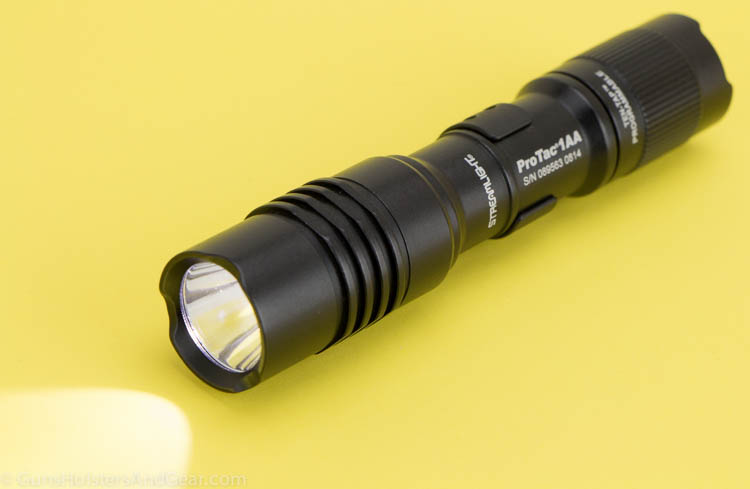
The front edge of the flashlight head has scallop cuts. These cuts allow light to escape if the flashlight is placed on a hard surface, head down. The escaping light lets you know that you left the flashlight on so you don’t run the battery down.
As with many of the flashlights currently on the market, the ProTac 1AA is made in China. Streamlight protects the light with a limited lifetime warranty.
Specifications
As stated at the start of this review, Streamlight now offers the ProTac 1L-1AA: an upgraded version of the original 1AA flashlight. Here are the specs for the original compared to the newer tactical light:
| ProTac 1AA | ProTac 1L-1AA | |
| Total Light Output | 70 lumens | 350 lumens |
| Peak Beam Intensity | 1,450 candelas | 6,400 candelas |
| Beam Distance | 76 meters | 160 meters |
| Runtime | 1 hour | 1.3 hours |
| Battery Type(s) | 1x AA | 1 AA or 1 CR123A |
| Length | 4.2″ | 4.3″ |
| Weight | 2.3 oz | 2.8 oz |
| Impact Resistance | 2 meters | 2 meters |
| Water Resistance | IPX7 (1 meter for 30 minutes) | IPX7 (1 meter for 30 minutes) |
Initial Observations
This light can nearly disappear in your hand. It is barely longer than the width of my hand. While I never had any problems, for people with very large hands, this could be an issue for you when deploying the light with an overhand grip.
Like other Streamlight flashlights I have tested, the ProTac 1AA has a rich, black finish that both looks and feels good. It arrived without any blemishes. The threads in the tail cap seemed smooth and lacked any roughness that I have occasionally encountered with some inexpensive flashlights.
Output Levels
Light output levels are generally expressed in three different ways: lumens, candela and beam distance. When you know the three expressions for a flashlight, you can draw some reasonable conclusions about the light’s output.
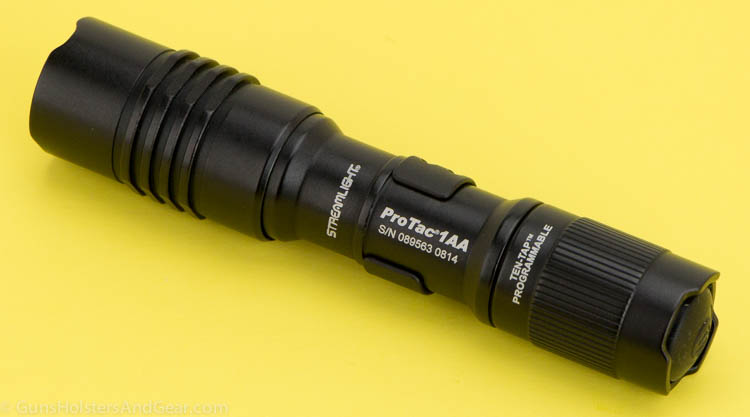
Lumens describes the total of the light without regard to focus. Candela, on the other hand, is a unit of measure for the peak beam intensity. High lumens with low candelas suggests a bright flood-type pattern, while high lumens with high candelas suggests a bright, focused beam. Beam distance is an expression in meters for how far away the flashlight can project 0.25 lux of light (roughly the brightness of the object when illuminated by a full moon.)
For companies that voluntarily adhere to the ANSI/NEMA FL 1 standard, there are specific ways of measuring the light output. Streamlight is one of the original companies to jump on board with the ANSI standard, and the company’s lights all express standardized measurements.
Switch
A single tail cap switch controls all aspects of this light’s output. Streamlight uses a programable switch called Ten-Tap in this and other ProTac lights. The user can use the Ten-Tap to program the light to operate in one of several different programs.
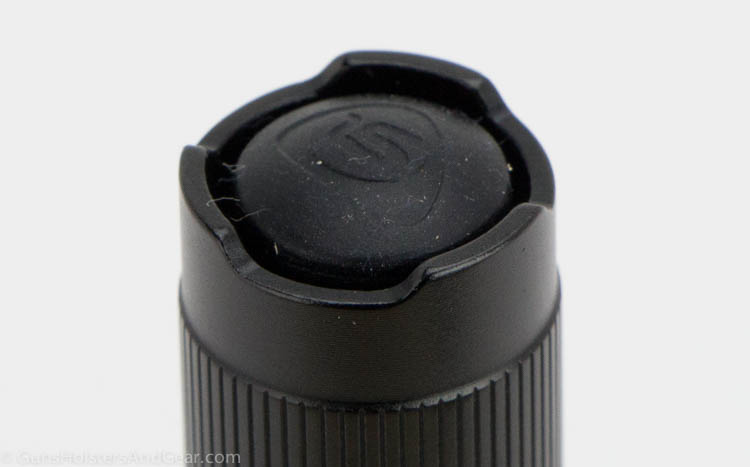
As it ships, the light will cycle between high – strobe – low as you tap, double-tap or triple-tap the switch. If you momentarily press the switch, it will not cycle: each time it will come on in the high mode. It is only when you very rapidly double- or triple-tap the switch that it moves from one mode to the next.
From a practical standpoint, I’ve found the Ten-Tap switch to work very well for me. As a former police officer, I could easily conduct building searches with this light’s big brother, the ProTac HL3, and not run into a situation where the light would move to an unexpected mode. However, if I wanted a strobe or low power mode, I could quickly call it into service. In my experimentation with the 1AA, I found it works exactly the same as the HL3.
If you want the light to only come on in high, the Ten-Tap allows you to program the light to do just this. Frankly, I think it is one of the better systems on the market.
Testing
There is a lack of quality testing and honest reviews on the internet today. I aim to change all of that with my flashlight reviews.
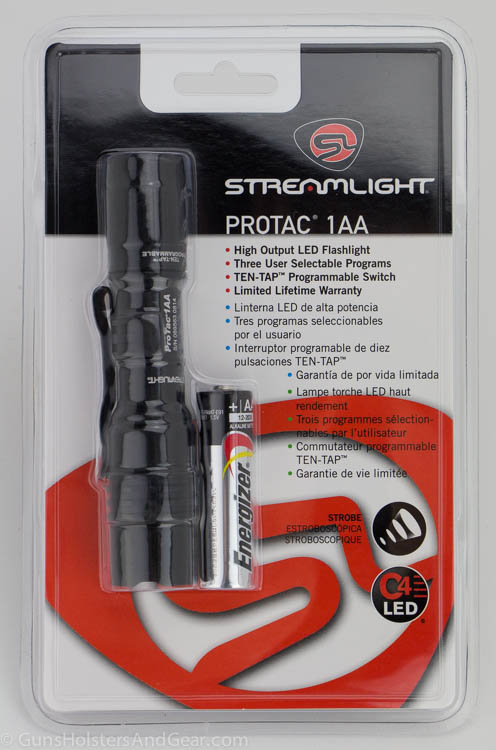
I have a set of tests that I put all lights through. This set of tests were developed over a long period of time, and test many of the things that manufacturers make claims about. Specifically, I test for:
- runtime (light output over time)
- body heat
- impact resistance
- waterproofing
Also, I provide photos of the flashlight operating at a known distance.
My tests are not ANSI/NEMA FL 1 standard tests. Some of my tests are harder, and all of them are reported here. If a light fails some aspect of the testing process, I will let you know about it. Likewise, if it exceeds expectations, I will happily tell you about that as well.
Output Over Time
I use an integrating sphere to measure output over time. The sphere is not a scientific-grade sphere that can cost $10k or more. However, I have tested the sphere enough to be comfortable in using readings from it in a relative sense. It is not, nor is it intended to be any kind of measure of the published lumens output of the light. For that, you need a professional sphere.
The integrating sphere can measure output over time, and give a good estimation of the amount of light relative to its peak. In other words, with reasonable accuracy, I can state the runtime to a specific % of output. Additionally, the lux readings from one flashlight can be compared to the lux readings from another flashlight tested in this sphere.
With a fresh alkaline battery, the ProTac 1AA produced the following output:
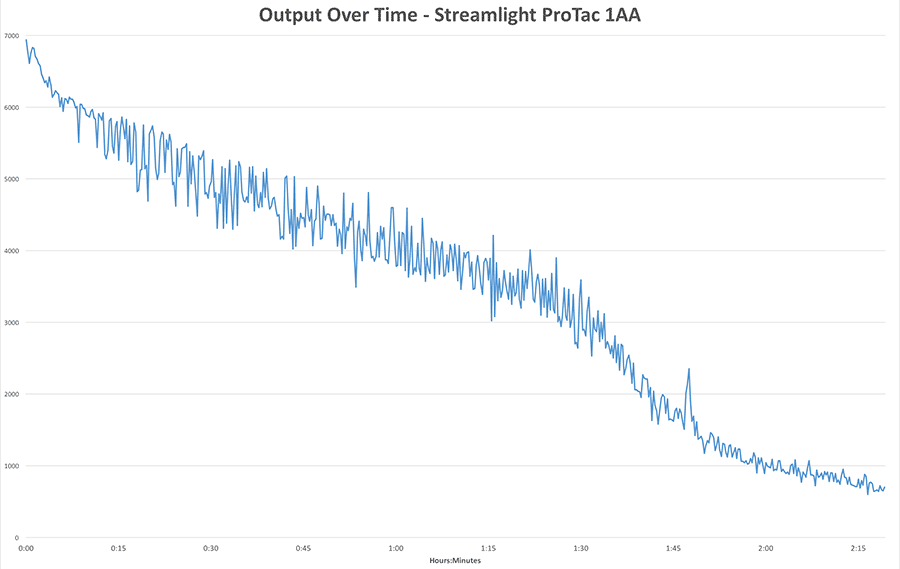
As you can see in the performance chart, output falls off gradually over time. Runtime per the FL 1 standard is from the peak (after 30 seconds of running) until the output reaches 10%. For a 10% output, I measured runtime to be 2 hours and 18 minutes. This easily exceeds the stated runtime given by Streamlight.
One of the more important things I measure is the 50% output runtime. This measures the amount of time it takes for a flashlight to reach only half of its original output level. I find this to be a much more useful stat than the FL 1 number. A lot of people will swap batteries around the halfway mark, so I think this is a better number to list as the runtime.
For the 50% output runtime, the ProTac 1AA measured 1 hour, 17 minutes. This is a respectable number, and far exceeds some of its competitors. For example, the Nightstick MT-210, another 1 AA battery flashlight I tested, only measured a 50% output runtime of 6 minutes. Yet, the company claims a FL 1 runtime of 1 hour 30 minutes.
The below video is a visual representation of the flashlight’s output over two hours. The video is not intended to quantify the amount of light being produced, but rather a visual representation of the data recorded. When you watch the video, notice the timer as the light output drops significantly. It is right about the same time I measure the 50% runtime.
Heat Generation
As I’ve talked about before, flashlights can get hot when run for long periods of time. I now measure surface temperature over time to give you an idea of what to expect from the torch.
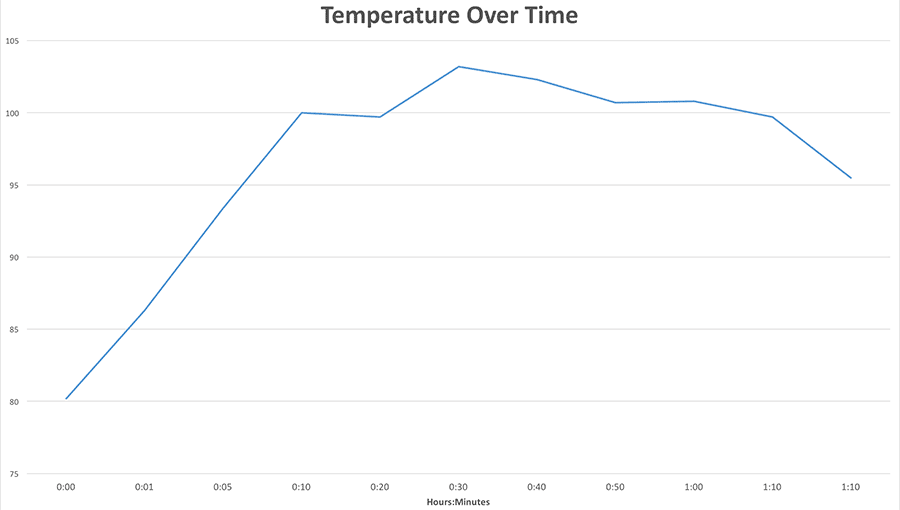
As you can see, temps do rise the longer the light is on. However, the light peaked shy of 105° F at the 30 minute mark. While 105° is not cool, it is actually cooler than a hot summer day in some parts of the United States. The barrel of the light gets warm, but it will not burn your hand.
Visual Comparison
All of the data in the world can’t give you as much information as a single good picture. The following is a pair of photos showing how much light the ProTac 1AA flashlight puts out.

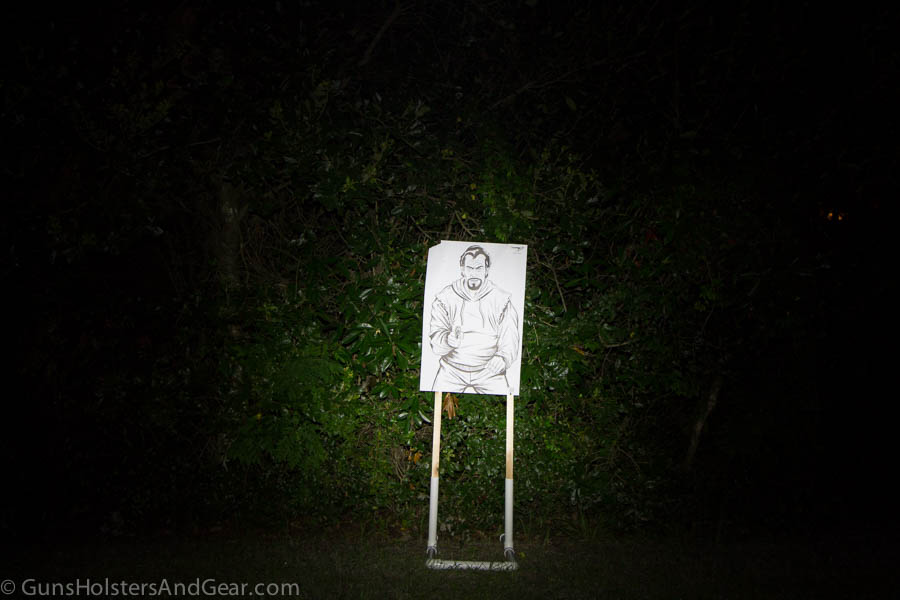
The photo on the left is a control photo taken at the same exposure as the one on the right. The photo on the right is the flashlight on the high output level with a fresh battery. Click or touch the slider in the center of the photo to drag it right or left.
Both images were taken at a distance of 25′ from the target.
Drop Test
As with many modern flashlights, the body of the ProTac 1AA is aluminum. According to Streamlight, the aluminum is a 6000-series metal, and it has a black anodized finish. As I stated above, the finish looks and feels good.
Streamlight states this flashlight is impact resistant to 2 meters. The FL 1 testing standard is to imagine the light as a cube and to drop it from each of the six “sides” onto cured concrete. My test is similar to the FL 1 test, though not in a controlled environment.
Using my sidewalk and step ladder, I put the light to the drop test:
As you can see, the light continued to work after hitting concrete six times. I’m in the process of testing a light from another manufacturer that is much more expensive than the ProTac 1AA that failed this test. So, don’t think that this test is a mere formality. Some lights can’t hack it.
I was pleasantly surprised that the light showed little damage from the drops. I’ve carried Streamlight flashlights as a cop for many years, and I have always been pleased with how well they hold up. However, I was not sure that a small pocket flashlight would do as well. I was very happy to see that the 1AA bore the drops well.
Since the light passed the drop test, it was time to test the company’s claim about water resistance.
Water Resistance Test
Streamlight uses a single O-ring to help provide water resistance. The tail cap has a rubber-covered switch and the inside of the tail cap has a metal spring to complete the power circuit. The lens is made of glass and it also has an O-ring to help provide water resistance.
According to Streamlight, the ProTac 1AA is waterproof to one meter for 30 minutes. Of course, like the wounded robber in Dirty Harry, “I gots to know” if it will really perform.
Following the drop test above, I proceeded to test the water-resistance of the flashlight. For this test, I measured a length of paracord slightly longer than one meter. I then tied the light to the cord and suspended it at a one meter depth in a saltwater pool for 30 minutes. The pool temperature at the time of the test was 61° F.
I filmed the test in the video below:
After 30 minutes of submersion, I found there was no water intrusion into the flashlight. Additionally, the light worked normally, including the multi-function switch. (Update: It’s been more than 5 years since I did the submersion test, and the light has not shown any problems.)
Final Thoughts
The Streamlight ProTac 1AA is a solid performer that appears to live up to all of the specs the company laid out for it. The run time on a single AA battery is good, exceeding the 10% output runtime claimed by the company. The 50% output runtime is 77 minutes, which is fairly good for a single alkaline battery.
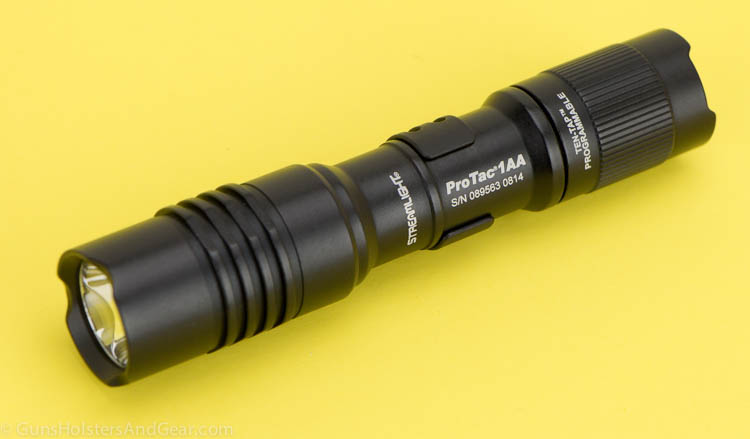
The MSRP is a bit high, but the street price (around $40-45 for the ProTac 1L-1AA) is much more reasonable.
For an EDC light that is likely to stand up to any reasonable environment you will run into, the ProTac 1AA is a good pick. Another good choice is the Streamlight 1AAA that runs on a single AAA battery and is slightly less expensive. Click here to read my review of that light. If you own the ProTac 1AA, leave your thoughts on the light in the comments section below.
Last Update: August 21, 2021
Disclosure
This review was prompted by my recent review of the Nightstick MT-210 flashlight. After completing that review I was asked to compare the two lights head-to-head. I contacted Streamlight, and they agreed to send me this light for testing.
Streamlight is not currently, nor have they ever been, a sponsor of or advertiser on this site or any that I own. I am not currently in any discussions for them to be one.
GunsHolstersAndGear.com is a for-profit website. I do not charge readers a dime to access the information I provide.
Some of the links on this page and site are affiliate links to companies like Amazon and Palmetto State Armory. These links take you to the products mentioned in the article. Should you decide to purchase something from one of those companies, I make a small commission.
The links do not change your purchase price. I do not get to see what any individual purchases.
Special note: Since I wrote this review in January of 2015, I’ve updated my flashlight testing protocols. (Click here to read more.) In keeping with the new protocols, I have added additional information in this article, including runtime and temperature data.
